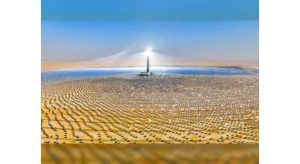A global transition towards more sustainable production and consumption systems is underway. This transition process is particularly visible in energy systems, where modern renewables, majorly solar PV and wind power, accounted for around 10 % of global power production in 2020. It is widely believed that the transition to a low carbon economy would inevitably increase energy storage requirement to a significant extent in the near future. In this context, concentrated solar power (CSP) technologies are seen to be one of the most promising ways to generate electric power in coming decades. To reduce the cost of power generation from CSP technologies, over 1000 articles have been published in the last five years, and it is necessary to observe the overall research and technological advancements in this sector which is missing in the current literature. To bridge this gap, this work presents a comprehensive review on the actual state of all major components of cutting-edge CSP technologies and condenses all the available information and categorizes them considering the main functional parts and remarking the current research progress in each part as well as the future challenging issues. It intends to understand and explain the foundations of the innovative concepts, future research directions and strategies developed over the past 10 years to tune the engineering and thermal sciences of concentrated solar power. It is evident that the cost has come down, however to make the cost of CSP technology at par with other renewable power sources, there are multiple challenges especially in water consumption, materials design, and receiver subsystems. Each of these challenges is discussed in detail and suggestions are presented for addressing the challenges. The information and insights presented in this detailed review study is expected to serve as a good resource for practicing engineers and researchers intending to undertake their research on this subject.
Introduction
The world’s energy system is undergoing major changes as we move towards a net-zero carbon economy. Indeed, the undeniable impact of greenhouse gas (GHG) emissions on the climate encourages countries around the world to progressively promote renewable energy technologies. However, due to intrinsic intermittency of renewable energies such as wind and solar photovoltaic, their large-scale introduction will pose a challenge for the stability of the power grid, as unexpected changes in local meteorology can significantly alter the production wind and solar PV power. Therefore introducing more variable renewable energy sources (VRES), namely wind and solar PV generation into the energy mix puts pressure on the power system. Concentrated solar power (CSP) is a technology offering a solution to this problem, because unlike conventional solar PV plants, CSP plants can incorporate thermal energy storage (TES) systems such as molten salt energy storage to allow them to generate electric power whenever it is needed – day and night, regardless of the weather conditions. This makes CSP a far more promising solution for large scale power generation from solar and therefore the most suitable technology to promote a massive penetration of solar energy in the power generation industry.
CSP technologies are among the most viable and promising renewable energy technologies that can be scaled up for a rapid transition towards high renewable energy utilization scenario (Calvet et al., 2021, Fang and Zhao, 2020, Giaconia et al., 2020, Laporte-Azcué et al., 2020, Liu et al., 2022, Martínez et al., 2020, Powell et al., 2017; W. Wang et al., 2021a, Wang, 2019). While the bulk of CSP electricity will come from large, on-grid power plants, these technologies also show significant potential for supplying specialized demands such as process heat for industry, co-generation of heating, cooling and power, and water desalination. CSP also holds potential for applications such as household cooking and small-scale manufacturing that are important for the developing world. The possibility of using CSP technologies to produce solar fuels (e.g. hydrogen and jet fuels), is another important aspect of CSP which strengthen its role in the low carbon economy. Moreover to mitigate the climate change, the IEA says that by the end of the century, CO2 will need to be removed to keep temperature rise to under 2°. So, along with switching to renewable energy, we will need to remove carbon dioxide from the air. Heat is required to perform the thermochemistry involved in CO2 air capture. As the heat-based form of solar energy, CSP is well positioned to play a key role in CO2 removal, to begin to rebalance the earth’s atmospheric chemistry. It is expected that CSP, together with wind and solar photovoltaic, will constitute a stable, high percentage of renewable energy generation system that will be price-competitive with conventional energy sources (Agency, 2021, IRENA, A.D., 2014, Zhang et al., 2021).
However, the cost reductions achieved by rival technologies (mainly solar PV) force CSP developers to go further in the search of cost reductions due a highly competitive market and the lack of tariffs that correctly value the dispatchability of CSP. While CSP has been widely criticized for being expensive and often inefficient, the tables are now turning. Technology has improved significantly, costs are falling rapidly, and most importantly, environmental benefits are increasing. In fact, many governments around the world have made decisions to increase the use of solar thermal power over traditional fossil fuels such as coal. For example, this year (2022) four Chinese provinces have announced to build 24 CSP plants with a combined capacity of 2450 MW by 2024 (Kraemer, 2022a, Kraemer, 2022b, Kraemer, 2022c). Each of the planned projects includes at least 6 h of low cost thermal energy storage (most of them include ≥9 h). The current TES costs are low compared to storage in chemical batteries, which suggests a role for CSP with TES (i.e., CSP + TES) relative to PV+ batteries, due to favorable storage costs for TES despite the disadvantage in generation costs for CSP (Kennedy et al., 2022).
Section snippets
Motivation and objectives
The commercialization of the CSP technologies in recent years has led to a great deal of progress in various topics such as concentrators, receivers, point and line focus technologies, heat transfer fluids, heat storage materials, control, etc. Given the multitude of recent studies as well as ongoing efforts in developing CSP technologies, it is considered timely to offer a comprehensive review by covering an overall perspective in the recent progress in CSP research at commercial level.
Current status of the CSP market
As shown in Fig. 1, the historical development of CSP plants is characterized by strong ups and downs in a sequence of boom-bust cycles triggered by changes in national policy support (Lilliestam et al., 2021b). The first wave of CSP development took place in the California, United States during the 1980 s, when Federal and State policies and tax incentives led to the construction of nine CSP plants of some 350 MW generation capacity between 1984 and 1991. Falling energy prices, delays in the
Basic physics of CSP
To use the sun energy, a CSP plant uses mirrors to focus sunlight onto a receiver where a heat transfer fluid (HTF) is heated. The heated HTF can then be stored thermally to be dispatched when required. The energy contained in HTF is ultimately transferred to the steam. Electricity is then generated by a steam turbine with the efficiency limited by the Carnot cycle. Therefore, the coupling of thermal energy storage (TES) and a turbine allows CSP to replace existing power generation such as coal
Key requirements for CSP plants
CSPs require specific environmental and socioeconomic factors to be commissioned, financed, and built successfully and effectively. These factors are:
Overview of mainstream CSP technologies
The solar energy system can be categorized into two group’s i.e. active and passive technologies. The passive technology means collecting solar power without converting thermal or light energy, while the active solar system absorbs solar radiation (Herrando and Markides, 2016). The active solar system can be further grouped into photovoltaic (PV) and concentrated solar power (CSP) systems. The concentrated solar system can be grouped in two classes i.e. point focus and line focus (Fig. 7).
At
CSP cooling system
All commercial CSP technologies (PTC, SPT and RFC) rely on steam Rankine power cycles that are essentially the same as those used in coal and nuclear power plants. Completing the cycle in a Rankine power block requires a cooling system to condense steam back into water. While most water is reused in the cycle, water is still needed for the steam cycle make-up. The water is used to ensure the steam generation (4–8 %), the cooling of the power-block (82–94 % in case of wet cooling) and the
Next generation CSP with advanced HTF and TES
The prime focus of next generation (3rd generation) CSP is to reduce the LCoE by improving solar-electric efficiency with increase in the operational temperatures (greater than600 °C) above the state of art application. To achieve high thermal-to-electric conversion efficiency and to lower electricity production from renewables, different initiatives have been launched across different countries. Some of the major initiatives include:

European DISTOR Project: The aim of this project (funded by
Conclusions and future directions
This work provides an extensive review on all major subcomponents of a CSP system. The following points can be inferred from the article.
Over the past ten years, there has been a significant growth in the installed capacity of CSP. Any large-scale CSP deployment in the next decade, however, will happen with existing technologies, both the recently commercialized molten-salt towers and the more proven parabolic troughs. Especially in the tower segment, economies of scale have yet to be realized
Declaration of Competing Interest
The authors declare that they have no known competing financial interests or personal relationships that could have appeared to influence the work reported in this paper.
Acknowledgement
Open Access funding was provided by Qatar National Library (QNL).
References (274)
- et al.
A comprehensive optical characterization of linear Fresnel collectors by means of an analytic study
Appl. Energy
(2017) - et al.
Solar radiation concentration features in Linear Fresnel Reflector arrays
Energ. Conver. Manage.
(2012) - et al.
Steady-state thermal analysis of an innovative receiver for linear Fresnel reflectors
Appl. Energy
(2012) - et al.
High concentration linear Fresnel reflectors
Energ. Conver. Manage.
(2013) - et al.
Parabolic trough collector or linear Fresnel collector? A comparison of optical features including thermal quality based on commercial solutions
Sol. Energy
(2016) - et al.
Radiative cooling and cold storage for concentrated solar power plants
Energy Storage and Saving
(2022) - et al.
An adaptive aerodynamic approach to mitigate convective losses from solar cavity receivers
Sol. Energy
(2021) - et al.
Simulation of GEMASOLAR-based solar tower plants for the Chinese energy market: influence of plant downsizing and location change
Renew. Energy
(2013)
Volumetric receivers in Solar Thermal Power Plants with Central Receiver System technology: A review
Sol. Energy
(2011)- et al.
Thermal and hydraulic evaluation of a linear Fresnel solar collector loop operated with molten salt and liquid metal
Appl. Energy
(2019)
Imran Khan, M., Asfand, F., & Al-Ghamdi, S. G. (2022). Progress in research and technological advancements of commercial concentrated solar thermal power plants. Solar Energy, 249, 183-226. https://doi.org/10.1016/j.solener.2022.10.041
Published at Solar Energy


